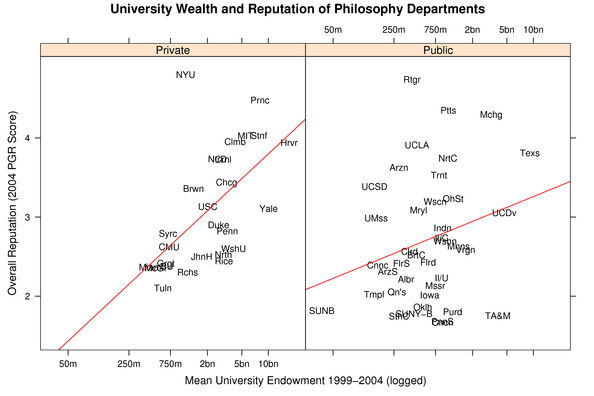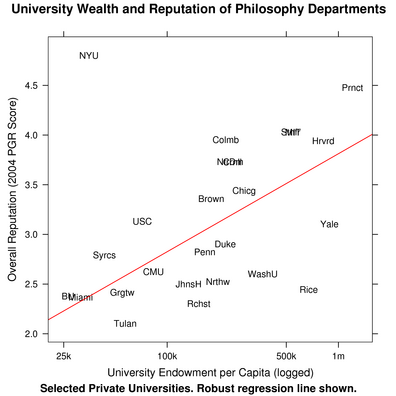by John Holbo on January 17, 2006
A few days ago Matthew Yglesias linked despairingly to a Caitlin Flanagan Atlantic book review/long article on ‘blowjob nation’ (and he wasn’t despairing because it was paywalled). Now I see (via Maud) it is available free online at Powell’s books. It seems to need a comment box; now it has one.
I myself will not comment, except to note that – in a sign of the times – TLS the Times just started a bunch of blogs. Just bought itself a typepad account, apparently. And – another sign of the times, perhaps – this venerable literary organ has allowed one of its tv critics (assigned to the Big Brother beat) to employ this image of herself (semi-worksafe). Like Flanagan, she appears to be named Caitlin. And that’s all I have to say.
by John Q on January 17, 2006
I’ve always thought that the Oil-For-Food scandal and the parallel scandal (promoted mainly on the left of the blogosphere) about corruption in Iraq’s postwar reconstruction were overblown. Under the circumstances, corruption was inevitable in both cases. If you supported feeding Iraqi children or attempting to repair the damage caused by the war, you had to expect, as part of the overhead, that those with power in Iraq would seek to skim money off the top, and that they would find willing accomplices in this task. Having said all that, corruption shouldn’t be passively accepted. It’s a crime and, wherever they can be caught, those guilty of it should be punished.
By far the biggest fish to be caught in the net so far is Australia’s monopoly wheat exporter, AWB, which was, until 1999, the government-owned Australian Wheat Board. It has become evident that AWB paid hundreds of millions of dollars to Saddam’s regime, and it has now been stated in evidence that the deals in question were discussed with Australia’s foreign minister, Alexander Downer., who has played a leading role in defending Australia’s participation in the Iraq war.
[click to continue…]
by Eszter Hargittai on January 17, 2006
Gone are the days when you had to clip letters from different newspapers and magazines to get a mix of fonts. This nifty tool lets you write out words with letter images from Flickr. (I assume the images have to be tagged with a letter to be part of the pool from which the program draws photos.) If you don’t like a particular letter design, you can click on just that one to get a different image.

For more Flickr goodness, you can keep track of the time using Clockr.
by Eszter Hargittai on January 17, 2006
The journal First Monday started publishing IT-related articles on the Web in May, 1996. The entire archives of the journal have remained freely accessible to the public over the years. First Monday will be celebrating its 10th anniversary this coming May in Chicago with a conference appropriately focusing on issues concering open collaboration on the Internet. In line with the journal’s history and the meeting’s topic, the program and related materials will be available online for all to see. Submissions are due February 6, 2006.
by Kieran Healy on January 17, 2006
I’ve been looking again at data from the “Philosophical Gourmet Report”:http://www.philosophicalgourmet.com/, “Brian Leiter’s”:http://leiterreports.typepad.com/ reputational survey of philosophers. Here are a couple of scatterplots showing the relationship between the size of a University’s endowment and the reputation of its philosophy department, as measured by the PGR, broken out by Private and Public universities. The red regression line in each panel shows the general association between the two variables. Only data for the U.S. are shown, and not all departments in the PGR are included. (Also available as a PDF file.)

The relationship is pretty strong for Private schools, and weaker for public ones. I believe this is because endowments better index the overall wealth of private than public schools, given that the latter get more money from the state. Of course, much as they would like to, philosophy departments don’t get to spend the whole endowment. But in a way this makes the strong tie between the two more interesting, both when it does obtain and when it doesn’t. NYU stands out. It’s a pretty rich university, but not spectacularly so. Yet it has the top-ranked philosophy department , which we would not expect at all based simply on its endowment. (Rutgers, the top-ranked public school and #2 overall, is also a very interesting case.) When it comes to investing in prestige, philosophers may be a good bet for an urban university. Occasional foodies notwithstanding, they do not take up much space compared to, say, particle accelerators or engineering labs. Also unlike particle accelerators, philosophers are fueled mainly by coffee, beer and small pastries. Rather than reflecting some conscious strategy at the university level, the strong performers might represent the existence either of substantial department-level resources accumulated over time, or the presence of entrepreneurial chairs or administrators who have managed to get their hands on extra money. Conversely, schools like Texas A&M and Yale do not do as well as we would expect on the basis of the overall wealth of the university.
*Update*: Here’s a plot of reputation against per capita endowment (per FTE student). I’ve only shown the private universities because I don’t think the endowment numbers for public schools are that informative. Once again, you can see NYU is a big outlier. Rice also appears as a distinctive observation with this measure. (A “PDF version”:http://www.kieranhealy.org/files/misc/endow-percap-priv-pgr.pdf is available as before.)


